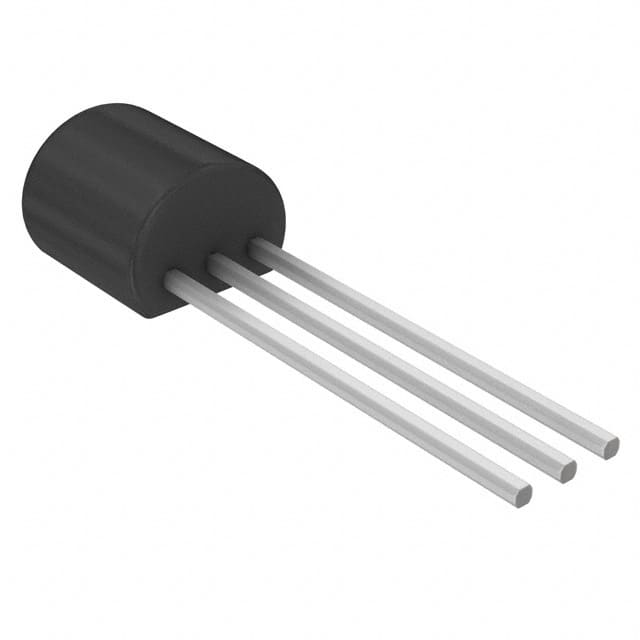Viz Specifikace pro podrobnosti o produktu.

BC560BBU
Introduction
The BC560BBU is a versatile and widely used transistor that belongs to the category of bipolar junction transistors (BJTs). This entry provides an overview of the basic information, specifications, detailed pin configuration, functional features, advantages and disadvantages, working principles, application field plans, and alternative models of the BC560BBU.
Basic Information Overview
- Category: Bipolar Junction Transistor (BJT)
- Use: Amplification and switching in electronic circuits
- Characteristics: High current gain, low noise, and low distortion
- Package: TO-92 package
- Essence: NPN silicon epitaxial planar transistor
- Packaging/Quantity: Typically available in reels or tubes with varying quantities
Specifications
- Collector-Base Voltage (VCBO): 45V
- Collector-Emitter Voltage (VCEO): 45V
- Emitter-Base Voltage (VEBO): 5V
- Collector Current (IC): 100mA
- Power Dissipation (PD): 625mW
- Transition Frequency (ft): 150MHz
- Operating Temperature Range: -55°C to 150°C
Detailed Pin Configuration
The BC560BBU transistor has three pins: 1. Collector (C) 2. Base (B) 3. Emitter (E)
Functional Features
- High current gain (hFE)
- Low noise and low distortion characteristics
- Suitable for audio amplification and general switching applications
Advantages and Disadvantages
Advantages
- High current gain allows for signal amplification without significant distortion
- Low noise makes it suitable for audio applications
- Wide operating temperature range enhances versatility
Disadvantages
- Relatively low collector current compared to some other transistors
- Limited power dissipation capability compared to higher-power transistors
Working Principles
The BC560BBU operates based on the principles of bipolar junction transistors. When a small current flows into the base terminal, it controls a larger current between the collector and emitter terminals, allowing for amplification or switching of signals in electronic circuits.
Detailed Application Field Plans
The BC560BBU finds extensive use in various electronic applications, including: - Audio amplifiers - Signal processing circuits - Switching circuits - Oscillator circuits - Voltage regulators
Detailed and Complete Alternative Models
Some alternative models to the BC560BBU include: - BC556B - 2N3904 - 2N4401 - BC547B - BC548B
In conclusion, the BC560BBU transistor offers high current gain, low noise, and low distortion, making it suitable for a wide range of electronic applications. Its compact TO-92 package and versatile characteristics make it a popular choice among electronics enthusiasts and professionals alike.
[Word count: 411]
Seznam 10 běžných otázek a odpovědí souvisejících s aplikací BC560BBU v technických řešeních
What is the BC560BBU transistor used for?
- The BC560BBU transistor is commonly used for amplification and switching applications in electronic circuits.
What are the key specifications of the BC560BBU transistor?
- The BC560BBU transistor typically has a maximum collector current of 100mA, a maximum collector-emitter voltage of 45V, and a maximum power dissipation of 625mW.
How do I identify the pinout of the BC560BBU transistor?
- The pinout of the BC560BBU transistor is typically as follows: the emitter is connected to the arrow symbol, the base is the middle pin, and the collector is the remaining pin.
Can the BC560BBU transistor be used for audio amplifier circuits?
- Yes, the BC560BBU transistor can be used in low-power audio amplifier circuits due to its amplification capabilities.
What are some common circuit configurations using the BC560BBU transistor?
- Common circuit configurations include common emitter, common base, and emitter follower configurations for amplification and switching purposes.
What are the temperature considerations for the BC560BBU transistor?
- The BC560BBU transistor typically operates within a temperature range of -65°C to 150°C, making it suitable for various environmental conditions.
Is the BC560BBU transistor suitable for high-frequency applications?
- While the BC560BBU transistor can be used in moderate frequency applications, it may not be ideal for very high-frequency applications due to its characteristics.
Can the BC560BBU transistor be used in voltage regulator circuits?
- Yes, the BC560BBU transistor can be utilized in voltage regulator circuits to provide stable output voltage regulation.
What are the typical gain characteristics of the BC560BBU transistor?
- The BC560BBU transistor typically has a moderate to high current gain (hFE) which makes it suitable for amplification purposes.
Are there any common alternatives to the BC560BBU transistor?
- Yes, common alternatives include transistors such as 2N3904, BC547, and BC548 which have similar characteristics and can be used in similar applications.

